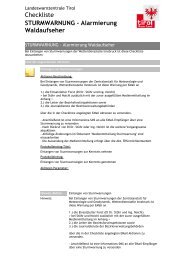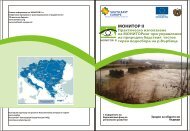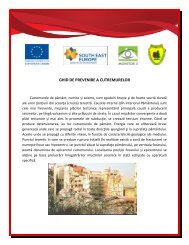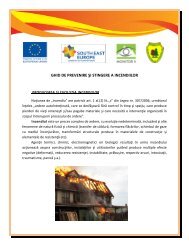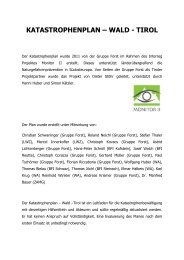risk management - monitor ii
risk management - monitor ii
risk management - monitor ii
You also want an ePaper? Increase the reach of your titles
YUMPU automatically turns print PDFs into web optimized ePapers that Google loves.
6 Monitor II Risk <strong>management</strong> introduction<br />
Monitor II Risk <strong>management</strong> introduction 7<br />
Risk <strong>management</strong><br />
Figure 2: Basic social <strong>risk</strong> terms (S. KOLLARITS et al. 2007)<br />
social concepts no communication about<br />
objects and events is possible, because they<br />
provide the basis for mutual understanding.<br />
But this classification is always depending on<br />
context as much as on the social collective,<br />
which finds agreement on a specific social<br />
concept. Social concepts can thus not be seen<br />
as constants, but rather as changing views of<br />
the world, depending on a common<br />
agreement of some social collective.<br />
The starting point for any discussion of disaster<br />
<strong>management</strong> is the term damage.<br />
on terms<br />
Damage<br />
A damage (is the social concept<br />
which) classifies an impact of<br />
some event to have negative<br />
consequences.<br />
Loss<br />
A loss is damage quantified by<br />
values.<br />
Value<br />
A value (is the social concept<br />
which) classifies an object according<br />
to a specified value scale.<br />
This scale reflects the social<br />
principles, goals, or standards held<br />
or accepted by an individual, class,<br />
society or other social object.<br />
Based on this general view of a<br />
value system the value in a<br />
narrower sense can be defined in<br />
money or goods (market price).<br />
on terms<br />
Based on the concept of damage<br />
the term hazard can be defined:<br />
Hazard<br />
Hazard is an event, which causes<br />
damage. This includes both the<br />
actual event and the potential event.<br />
The term hazard thus depends on<br />
the definition of damage.<br />
Vulnerability<br />
Vulnerability is the quality of<br />
(objects of) the environment, which<br />
determines damage, given a<br />
defined (hazardous) event.<br />
Vulnerability is thus the quality<br />
of an object, which describes its<br />
probability of getting harmed in an<br />
event. Vulnerability can be seen as<br />
inversely related to the capacities<br />
of objects to anticipate, to cope<br />
with, to resist and to recover from<br />
an extreme event.<br />
Risk<br />
Here <strong>risk</strong> is seen as a quality (the<br />
probability) of an impact, which is<br />
classified as damage. In more casual<br />
language this would mean that <strong>risk</strong><br />
is the probability that something<br />
(anything) negative will happen.<br />
Elements at <strong>risk</strong><br />
Objects of the environment,<br />
which are (spatially, temporally)<br />
exposed to hazards.<br />
A scenario is a description of<br />
a course of future events, based<br />
on a consistent and plausible<br />
set of assumptions about future<br />
conditions.<br />
Risk <strong>management</strong> deals with hazards and is<br />
the continuous, process-like <strong>management</strong><br />
which aims at reducing <strong>risk</strong> to an acceptable<br />
level (acceptable <strong>risk</strong>). The corresponding goal<br />
situation is security.<br />
For <strong>risk</strong> <strong>management</strong> the society – explicitly<br />
or implicitly – first defines the acceptable level<br />
of <strong>risk</strong> (normatively). Risk <strong>management</strong> assesses<br />
<strong>risk</strong> and defines and implements the measures<br />
necessary to reach this acceptable level of <strong>risk</strong>.<br />
The <strong>risk</strong> remaining is the residual <strong>risk</strong>.<br />
If all measures defined have been implemented<br />
then the residual <strong>risk</strong> is the <strong>risk</strong> resulting<br />
from hazardous events, which have not been<br />
accounted for in terms of intensity of the event.<br />
Risk <strong>management</strong> is concerned with extreme<br />
events, which are not accounted for in the<br />
everyday routines of dealing with <strong>risk</strong> and can<br />
thus lead to severe negative consequences.<br />
Scenario<br />
In order to be able to treat <strong>risk</strong>, i.e. to<br />
implement measures for <strong>risk</strong> reduction,<br />
assumptions about possible events and their<br />
impacts must be defined. These assumptions<br />
are called scenarios and serve as a starting<br />
point of all <strong>risk</strong> <strong>management</strong> activities.<br />
These conditions usually describe parameters<br />
of events (e.g. rainfall intensity above a certain<br />
threshold) and capacities of objects (e.g.<br />
function or failure of protective structures).<br />
All disaster related <strong>management</strong> strategies<br />
are related to a scenario of a defined extent<br />
(characterized by the intensity of the the event<br />
and the vulnerability of the elements at <strong>risk</strong>).<br />
Thus any <strong>risk</strong> <strong>management</strong> strategy depends<br />
on pre-defined scenarios.<br />
Risk treatment strategies provide different<br />
principles (methods) for the definition of <strong>risk</strong><br />
treatment measures.<br />
Seen from the perspective of a disaster event,<br />
<strong>risk</strong> <strong>management</strong> is a cycle of recurrent<br />
activities. This cycle has been named “<strong>risk</strong><br />
<strong>management</strong> cycle”. For MONITOR II the<br />
current definitions of PLANALP where taken<br />
as a starting point (figure 4).



